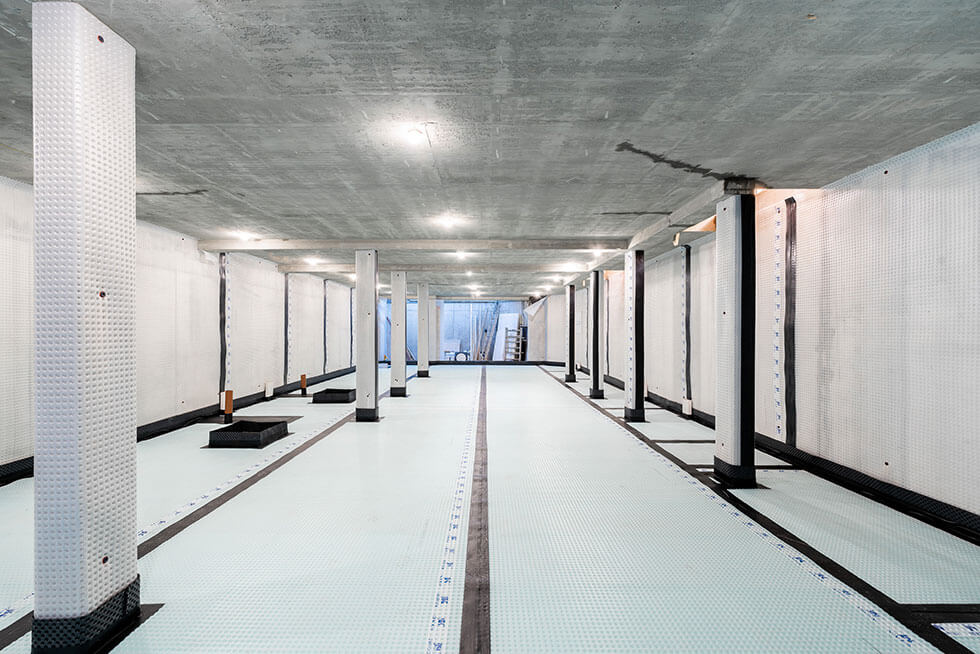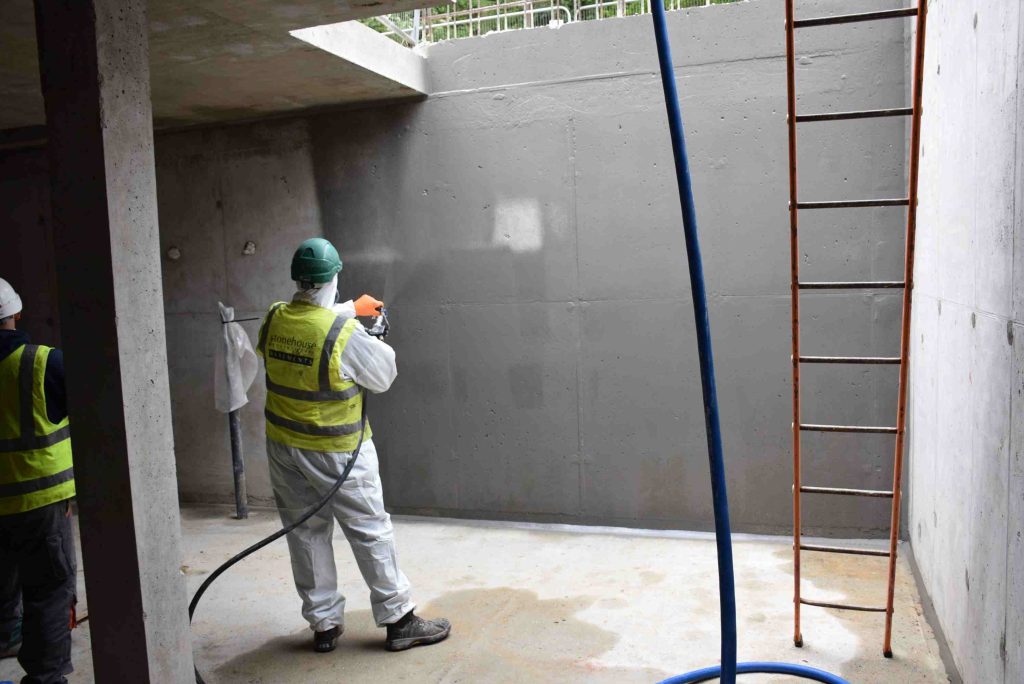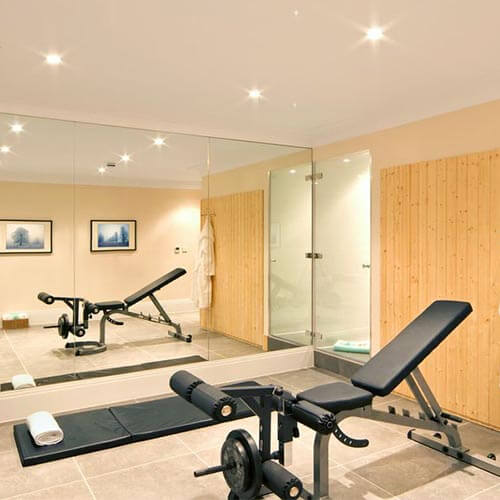01732 360 095
Keeping basement or cellar walls protected from water ingress is one of several important steps involved in the process of transforming a basement into a safe and habitable space.
Furthermore, whilst there are numerous options for how to waterproof your below ground walls, it is important to choose the right system appropriate to the waterproofing scenario in order to keep a property well protected.
In this guide, we will explore the different types of below ground waterproofing systems, what you need to know and when you should consider each one for the waterproofing of below-ground walls.
What Are the Key Considerations When Choosing the Best Below Ground Waterproofing System?
Water ingress into an inhabited basement can lead to serious damage and safety concerns, as well as extremely costly remedial work, so choosing the best waterproofing system for below-ground walls is vital.
Below-ground walls, much like any part of a below-ground structure, can be susceptible to water penetration. If a property is in a flood risk area, has a higher water table, or if the intent is to utilise the below-ground as a habitable space, then your below-ground walls will need more thorough protection as part of a holistic approach to waterproofing the whole structure.
It’s also important that the waterproofing system complies with regulations and best practice. British Standard 8102:2022 is the code of practice for the UK waterproofing industry, and it provides guidance on the correct design and specification of the different types of waterproofing.
Where the ground is sloping, with high ground levels to just one wall, it may be possible to waterproof just the walls using an externally applied system as detailed below, but it should be understood that where the ground is flat, water pressure comes from below, and so where the strategy is to provide a space that meets the client’s expectations and in nearly all cases this includes waterproofing the whole structure, not just the walls.
In nearly all cases where the waterproofing is carried out to the inside of the structure, the waterproofing will extend to the floors also.
The British Standard defines the three types of waterproofing as:
- Type A – tanking/barrier protection – can be applied to walls only on sloping sites when applied externally. Internally the system must lap to the floor, or be applied to the floors also
- Type B – structurally integral protection – the whole structure provides protection against water ingress
- Type C – cavity drainage Is generally applied to the walls and floor
Type A – Newton HydroBond and HydroCoat Systems

British Standard 8102:2022 defines ‘Type A’ waterproofing as “barrier protection”. This barrier protection can be applied to either the external or internal surface of a structure to resist any water that is trying to enter the building.
The Newton HydroBond System is a high-performance, Type A waterproofing system designed to be applied to the external surface of the below-ground structure.
HydroBond products can be pre-applied to the oversite/formwork, or post-applied where formwork is removed to expose the outside of the below-ground basement walls.
Depending on the type of structure it is applied to, the combination of HydroBond products can provide a continuous barrier around the full extent of the structure.
By contrast, the Newton HydroCoat System is an internal Type A waterproofing solution for projects that require an internally applied membrane to resist water ingress.
Internal ‘Type A’ membranes are often the products that are referred to when people talk about the process of “tanking” a basement to protect it from water. Tanking membranes that can be applied to the internal side of the structure include a variety of liquid-applied slurries that must actively hold back ingressing water, so it is crucial to select the correct product and to ensure that the substrate is prepared correctly.
The range of liquid applied slurries and reinforcement products in the Newton HydroCoat System offer a choice of third-party certified solutions, utilising advanced products that are also quick and easy to apply.
Type B – Newton HydroTank System

British Standard 8102:2022 defines Type B waterproofing as designing the structure itself to be integrally waterproof and the primary resistance to water ingress.
Nothing provides better primary resistance to water than a well-designed and well-placed reinforced concrete structure, designed in accordance with BS EN 1992 with sufficient steel reinforcement to limit flexural and sectional cracking and therefore produce watertight concrete elements.
The use of correctly designed and installed waterbars at the places where the concrete isn’t, such as at joints and penetrations, will result in a Type B structure that should be fully watertight.
The Newton HydroTank System is an integral Type B waterproofing solution for projects that require the below-ground structure itself to be integrally waterproof and to act as the primary resistance to water ingress.
This system includes a selection of waterbars, waterstops, tie-bolt hole and service entry sealing sysytems, sealants and capillary blocking treatments that are used to seal the joints and penetrations through the concrete and achieve an effective Type B structure.
Type C – Newton CDM System

British Standard 8102:2022 defines Type C waterproofing as “drained protection” where water leaking through the structure is accepted into voids and air spaces, created by cavity drain membranes that are strategically placed to the inside of the structure, depressurising the incoming water and safely removing it from the property.
The Newton CDM System is a comprehensive Type C waterproofing system and will usually be suggested as one of the forms of waterproofing where a completely dry internal environment is required.
This maintainable basement waterproofing solution is ideal for both new-build basements and refurbishment projects. The system comprises of a range of BBA approved cavity drain membranes, coupled with bespoke sump and pump configurations, backup systems, and associated control and telemetry systems, making it the most reliable and maintainable waterproofing solution for any habitable space below ground.
How Can Newton Waterproofing Help You?
We are dedicated to providing high-quality waterproofing services throughout the UK, and our team of experienced professionals and specialist contractors have the expertise to tackle even the most challenging projects. We adhere to industry standards and use proven methods, ensuring long-lasting results and peace of mind, so contact us today to get started.
Speak to our friendly, expert team
Our staff are able to provide guidance for projects of all sizes, whether you require some general advice about damp or waterproofing, or support with technical drawings and specifications.

















